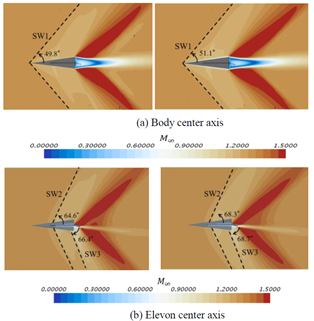Study on Aerodynamic Design for Mars Exploration Airplane
JAXA Supercomputer System Annual Report April 2016-March 2017
Report Number: R16E0052
- Responsible Representative: Seiichiro Morizawa(Tottori University)
- Contact Information: Seiichiro Morizawa(morizawa@mech.tottori-u.ac.jp)
- Members: Seiichiro Morizawa
- Subject Category: Space(Space engineering)
Abstract
It is necessary to understand the flow field under low Reynold and high Mach numbers conditions when we conduct the aerodynamic design for Mars exploration airplane. However, there is few studies on the flow field. Thus, we conduct the fluid simulations under the condition and aim to obtain the information of aerodynamic design for the airplane.
Goal
The Martian atmosphere is very thin, and its temperature is also lower. Thus, the flight condition of Mars exploration airplane is high Mach and low Reynolds numbers. It is necessary to understand the condition. However, there is few studies on the condition. The objective of this study is to investigate the fluid fields and aerodynamic characteristics for the airplane.
Objective
The targets of this study are Mars exploration airplane, its airfoil and planform, propeller blade. Then, fluid simulations under the low Reynold and high Mach numbers conditions will be conducted for them. Finally, we would like to obtain the information of these shapes with excellent aerodynamic performance by multi-objective design exploration (MODE).
References and Links
N/A
Use of the Supercomputer
In this study, the fluid fields and aerodynamic characteristics for Mars exploration airplane are investigated. For this purpose, fluid simulations withsuper-computer 'JSS2' are conducted because it is difficult to conduct vast cases and large-scale simulation when workstation at laboratory will do.
Necessity of the Supercomputer
There is few studies on fluid phenomena and aerodynamic characteristics for Mars airplane because the flight condition is high Mach and low Reynolds numbers flow. The condition on Mars is quite different from that on Earth, and it is difficult to reproduce the condition by wind tunnel. However, it is easier than wind tunnel to create the condition if we usesuper-computer. In addition, the available memory and CPU of it are much larger than workstation at our laboratory, and it is almost impossible to have such a computer by individual ownership. Therefore,super-computers are necessary to conduct our research.
Achievements of the Year
In this academic year, two applications for Mar exploration airplane are conducted. One is the aileron effect of the airplane with a deployable wing is investigated, and the other is a planform of swept-forward wing is investigated.
As for the aileron effect of the airplane with a deployable wing, the differences in the flow field and aerodynamic characteristics under Earth and Mars atmospheric conditions are compared. Then, the generation angles of shock waves under Mars atmospheric condition becomes larger than those under Earth atmospheric condition. In addition, the lift and rolling moment under Mars atmospheric conditions are lower than those of the Earth's are, whereas drag becomes larger than those under Earth atmospheric condition. This result indicates that the elevon effect of this airplane potentially destabilizes the rotation behavior and the gliding ability of the airplane under Mars atmospheric conditions.
As for a planform of swept-forward wing, fluid simulations at higher angle (α≧6°) are not successful. It is necessary to modify the program of the simulation, and we will modify next academic year. Then, we will investigate the effect of swept-forward wing, and prepare the setup for aerodynamic design by multi-objective design exploration (MODE).
Publications
Presentations
1) S. Morizawa, K. Sakamoto, A. Yasuda, A. Miyazaki, H. Kawazoe, 'Aileron Effect by the Elevon on the Aerodynamic Characteristics of a Mars Exploration Airplane with a Deployable-Wing, ' The 2016 Asia-Pasific Internatinal Symposium on Aerospace Technology, D1-2 , Toyama, Japan, October 25-27, 2016.
Computational Information
- Parallelization Methods: Serial
- Process Parallelization Methods: n/a
- Thread Parallelization Methods: n/a
- Number of Processes: 1
- Number of Threads per Process: 1
- Number of Nodes Used: 1
- Elapsed Time per Case (Hours): 5
- Number of Cases: 10
Resources Used
Total Amount of Virtual Cost(Yen): 91,871
Breakdown List by Resources
| System Name | Amount of Core Time(core x hours) | Virtual Cost(Yen) |
|---|---|---|
| SORA-MA | 21,110.12 | 34,720 |
| SORA-PP | 0.00 | 0 |
| SORA-LM | 0.00 | 0 |
| SORA-TPP | 0.00 | 0 |
| File System Name | Storage assigned(GiB) | Virtual Cost(Yen) |
|---|---|---|
| /home | 476.84 | 3,785 |
| /data | 4,768.37 | 37,858 |
| /ltmp | 1,953.13 | 15,506 |
| Archiving System Name | Storage used(TiB) | Virtual Cost(Yen) |
|---|---|---|
| J-SPACE | 0.00 | 0 |
Note: Virtual Cost=amount of cost, using the unit price list of JAXA Facility Utilization program(2016)
JAXA Supercomputer System Annual Report April 2016-March 2017




